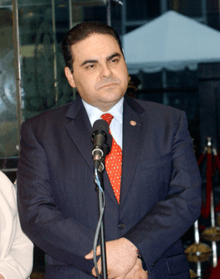2004 Salvadoran presidential election
A presidential election was held in El Salvador on Sunday, 21 March 2004. The Salvadoran people elected a new president, together with his vice-president, for a five-year term.
| ||||||||||||||||||||
| ||||||||||||||||||||
| ||||||||||||||||||||
 |
|---|
| This article is part of a series on the politics and government of El Salvador |
|
Executive |
|
Legislature
|
|
Administrative divisions |
|
|
|
|
Antonio "Tony" Saca of the ARENA party won the election. El Salvador's constitution provides for a second-round runoff vote in the event that no candidate secures an absolute majority; however, Saca's 57% share of the vote meant that the second round, scheduled for 2 May, would not take place.
Candidates
There were two front-running candidates:
- Antonio Saca of the ruling Nationalist Republican Alliance (ARENA). In his campaign, Saca embraced the free-market and pro-US policies followed by his predecessor and fellow arenista, Francisco Flores. He was also the clear favorite of the Bush administration.
- Schafik Handal of the opposition Farabundo Martí National Liberation Front (FMLN). Handal sought to capitalize on discontent over slow economic growth, increasing crime, and income disparities between the poor and the tiny elite. He pledged to raise the tax burden on the rich and to re-establish diplomatic relations with Cuba.
There were also two additional candidates. However, pre-vote opinion polls consistently placed both of them far behind the two leaders:
- Héctor Silva Argüello, the United Democratic Centre-Christian Democratic Party (CDU-PDC) alliance candidate.
- José Rafael Machuca Zelaya, representing the Party of National Conciliation (PCN).
The election was monitored by 270 international observers and El Salvador's own Tribunal Supremo Electoral, an institution created in 1992 to reform and validate the country's electoral system. Some 17,000 police were on security duty during the election.
Foreign interference
The U.S. government under George W. Bush interfered in the elections[2] by threatening a deterioration of the bilateral relations in case of a victory by FMLN's candidate Schafik Handal. Bush's Assistant Secretary of State for Western Hemisphere Affairs, Otto Reich, stated that the U.S. government was "concerned about the impact that an FMLN victory could have on the commercial, economic, and migration-related relations of the U.S. with El Salvador."[2]
Results
| Candidate, Party | Votes | % |
|---|---|---|
| Elías Antonio ("Tony") Saca González, Nationalist Republican Alliance (Alianza Republicana Nacionalista) | 1,314,436 | 57.71% |
| Schafik Jorge Handal, Farabundo Martí National Liberation Front (Frente Farabundo Martí para la Liberación Nacional) | 812,519 | 35.68% |
| Héctor Silva Argüello, United Democratic Centre-Christian Democratic Party (Centro Democrático Unido-Partido Demócrata Cristiano) | 88,737 | 3.90% |
| José Rafael Machuca Zelaya, Party of National Conciliation (Partido de Conciliación Nacional) | 61,781 | 2.71% |
| Total (turnout 67.3%) | 2,277,473 | 100.00 |
| Invalid votes | 40,508 | |
| Total votes cast | 2,317,981 | |
| Registered voters | 3,442,330 |
The election had a 67% turn-out (or 3.4 million voters), the highest in Salvadoran history. The Tribunal Supremo Electoral confirmed Saca as the winner on Monday 22 March.
Handal recognized Tony Saca's victory, but chose not to congratulate him. Saca announced his intention to seek reconciliation with the opposition FMLN, in an effort to heal old divisions from the country's violent past.
Saca selected Ana Vilma de Escobar to be his vice-president. She was previously the director of the Salvadoran Social Security Institute (ISSS). The new government took office on 1 June 2004.
External links
References
- Luis Eliezer Garcia. "Ministerio de Relaciones Exteriores de El Salvador » Autoridades » Titulares". Rree.gob.sv. Retrieved 2019-07-10.
- Dana Rohrabacher Speaks out on El Salvador Election, Clashes With Obama Administration Archived 2011-06-03 at the Wayback Machine

